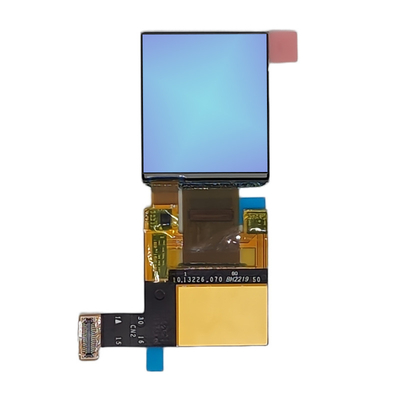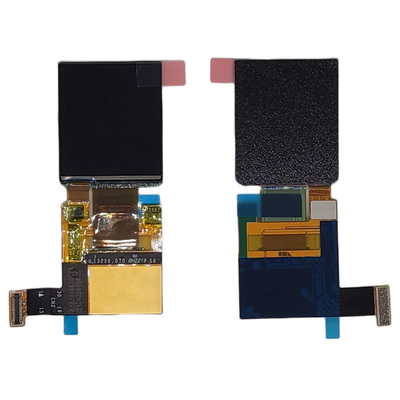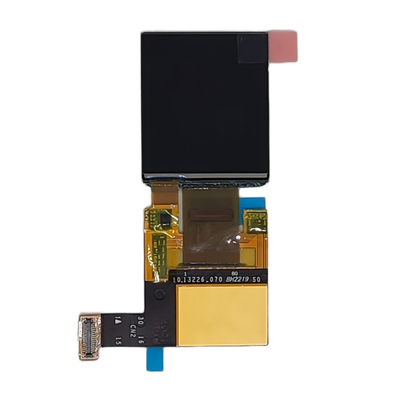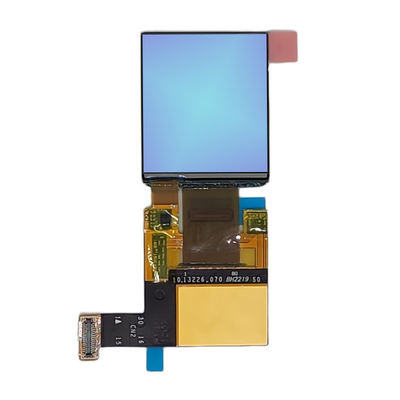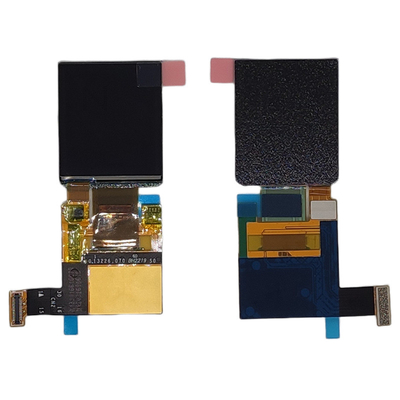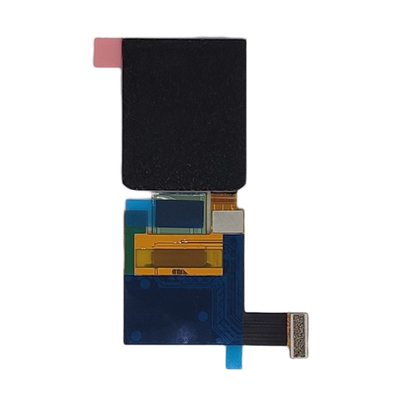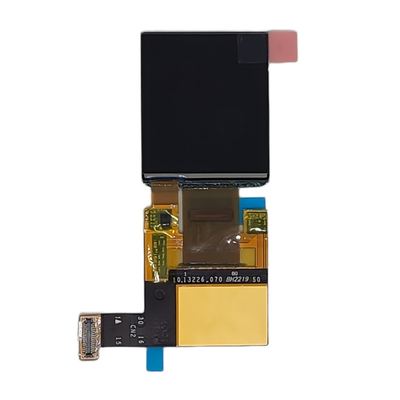-
จอแสดงผล LCD TFT
-
หน้าจอสัมผัส TFT Display
-
จอแสดงผล TFT แบบกลม
-
จอแสดงผลสี TFT
-
โมดูลแสดงผล AMOLED
-
จอแสดงผล Micro OLED
-
บาร์ประเภท TFT
-
จอ TFT สี่เหลี่ยม
-
จอ LCD ความสว่างสูง
-
จอ LCD COB
-
TFT ที่อ่านได้ในแสงแดด
-
จอแสดงผล UART TFT
-
โมดูลจอแสดงผล LCD
-
จอแสดงผล PMOLED
-
Epaper ดิสเพลย์
-
จอแสดงผล LED ดิจิตอล
-
แผงสัมผัสแบบ Capacitive
โมดูลแสดงผล AMOLED ขนาด 1.41 นิ้ว 320*360 พร้อมระบบสัมผัส OnCell ความละเอียด MIPI/SPI/QSPI Interface ไดรฟ์ IC 450C/D RM69330F12/SH8601A
| สถานที่กำเนิด | จีน |
|---|---|
| ชื่อแบรนด์ | HuaXin |
| ได้รับการรับรอง | ISO14001/ ISO9001/IATF16949 |
| หมายเลขรุ่น | ESHX0141320360 |
| จำนวนสั่งซื้อขั้นต่ำ | 1000 |
| ราคา | โปร่ง |
| รายละเอียดการบรรจุ | กระเป๋ากระเป๋ากระเป๋ากระเป๋ากระเป๋ากระเป๋ากระเป๋า |
| เวลาการส่งมอบ | 6 สัปดาห์ ~ 8 สัปดาห์ |
| เงื่อนไขการชำระเงิน | T/T |
| สามารถในการผลิต | 50K ต่อเดือน |

ติดต่อฉันเพื่อรับตัวอย่างและคูปองฟรี
WhatsApp:0086 18588475571
วีแชท: 0086 18588475571
สไกป์: sales10@aixton.com
หากคุณมีข้อสงสัย เราพร้อมให้ความช่วยเหลือทางออนไลน์ตลอด 24 ชั่วโมง
x| เทคโนโลยีการแสดง | หน้าจอสัมผัส AMOLED | ชื่อ | โมดูล AMOLED |
|---|---|---|---|
| ขนาด | 1.41 " | การแก้ไข | 320 x 360 |
| ความสว่าง | 450cd/m2 | อินเตอร์เฟซ | mipi/spi/qspi |
| ไดรฟ์ไอซี | RM69330F12/SH8601A | ||
| เน้น | โมดูลจอ AMOLED 320*360,QSPI อินเตอร์เฟซ AMOLED หน่วยจอ,อินเตอร์เฟซ MIPI AMOLED หน่วยแสดงภาพ |
||
ESHX0141320360เป็นโมดูล OLED AMOLED ขนาด 1.41 นิ้ว พร้อมระบบสัมผัส Oncell 320*360 การแก้ไข MIPI/SPI/QSPI อินเตอร์เฟส ความสว่าง 450 Cd/M2 สี OLED display ขับ IC คือ RM69330F12/SH8601A
A: ปริมาตรสินค้า
| ส่วนที่: | ESHX0141320360 |
| โหมดการแสดง | 1.41 นิ้ว จอ AMOLED |
| ขนาดของกรอบ ((มม) | 26.04 (W) x31.78 (H) x0.75 ((D) |
| ขนาด AA ((มม) | 23.84 × 2682 |
| แสดงจุด | 320*360 |
| มุมมอง | ทั้งหมด |
| ความสว่าง | 450 |
| อินเตอร์เฟซ | MIPI/SPI/QSPI |
| ไดรฟ์ IC | RM69330F12/SH8601A |
| การสัมผัส | oncell |
B: ภาพสินค้า
![]()
![]()
![]()
![]()
C: การวาด & ปินนิยาม
D: ความรู้เกี่ยวกับผลิตภัณฑ์
ข้อดีของ OLED:
เครื่อง OLED แข็งเบาและบางกว่าจอ LCD, ความแตกต่างสูง, ความอิ่มสีสูง, การบริโภคที่ต่ํากว่า
ข้อเสียของ OLED
AMOLED ราคาแพงมากกว่า LCD และ TFT อายุการใช้งานสั้นกว่า LCD และ TFT
E. ข้อมูลบริษัท
ข้อดีของ Huaxin:
1ฐานโรงงานที่ตั้งอยู่ในเมืองในประเทศ ซึ่งมีราคาประหยัด
2อุปกรณ์ใหม่ที่ทันสมัยที่สุด ที่สามารถรักษาคุณภาพได้
3. ส่วนใหญ่ของกระบวนการที่ใช้อุปกรณ์อัตโนมัติเต็ม ที่มีประสิทธิภาพและคุณภาพคง
4. วิศวกรมืออาชีพและผู้นําการผลิตที่ทํางานในสาขา LCD มากว่า 20 ปี
5. การออกแบบเองสําหรับผลิตภัณฑ์ที่กําหนดเอง
ใบรับรองของเรา
1.ISO14001 /
2.ISO9001/IATF16949
3.SGS ของโมดูล LCD
- Huaxin Technology (Enshi) Co.,LTD บริษัทที่เกี่ยวข้อง
- ฮูเบย์ เอ็นชิ
- วันที่ตั้ง:2009
- ธุรกิจเทคโนโลยีสูง ทํางานหลักๆในด้านการวิจัยและพัฒนา ผลิตและขาย LCD,LCM,TFT, Backlight,OLED
- LCD ประกอบด้วย: VA,TN, HTN, STN, FSTN, CSTN และชุดอื่น ๆ
- LCM ประกอบด้วย: COB,TBA,COG,TP,LED แบ็คไลท์และซีรีส์อื่น ๆ
- ทุนจดทะเบียน: 20 ล้าน
- พนักงานปัจจุบัน: 500+
- RD คิดเป็น 10%
- คิวซีมี 15%
F: ความสามารถในการผลิต
| ผลิตรายปี ความจุ |
2021 (ปัจจุบัน) | 2022 (เป้าหมาย) | 2023 (โจทย์) | 2024 (โจทย์) | 2025 (โจทย์) | คําสังเกต | ||
| LCD สินค้า ความจุ |
4.5 | 9 | 9 | 9 | 9 | หน่วย:พัน โลการิธม์/วัน |
||
| สินค้า LCM ความจุ |
70 | 150 | 300 | 450 | 450 | หน่วย: พัน ชิ้น/วัน |
||
| ไฟหลังผลิตภัณฑ์ ความจุ |
100 | 200 | 300 | 500 | 500 | หน่วย: พัน ชิ้น/วัน |
||
| สินค้า OLED ความจุ |
10 | 20 | 30 | 40 | 50 | หน่วย: พัน ชิ้น/วัน |
||
G: การใช้สินค้า
1กล่องความปลอดภัยและเครื่องมือ
2.lock&smart home โปรแกรมการใช้งาน
3.ตัวส่งและนาฬิกา
4.watch&radio
5.collimator&navigator
H: ลักษณะของจอ AMOLED
1. Self-E Missive พิกเซล:
2.คอนตราสต์เรชั่น:
3ความแม่นยําและความสดชื่นของสี
4มุมมอง:
5.ประสิทธิภาพการใช้พลังงาน:
6ความบางและความยืดหยุ่น:
7เวลาตอบสนอง:
I: ประสิทธิภาพการใช้พลังงานของ AMOLED เทียบกับเทคโนโลยีจออื่นๆอย่างไร?
1การใช้พลังงาน:
- จอ AMOLED ใช้พลังงานต่อพิกเซล ซึ่งหมายความว่าพิกเซลที่แสดงเนื้อหาสีดําหรือสีมืด ใช้พลังงานน้อยมากขณะที่พิกเซลที่แสดงเนื้อหาสีสดใสหรือสีขาวใช้พลังงานมากกว่า.
- ด้านจอ LCD และ LED ต้องการแสงเบื้องหลังที่ใช้พลังงานตลอดเวลา ไม่ว่าจะเป็นเนื้อหาที่แสดง
2ความพึ่งพาจากเนื้อหา:
- จอ AMOLED ประหยัดพลังงานมากขึ้นสําหรับเนื้อหาที่มีพื้นที่มืดหรือดํามาก เนื่องจากพิกเซลแต่ละตัวสามารถปิดเพื่อประหยัดพลังงานได้
- จอจอ LCD และ LED ใช้พลังงานที่ค่อนข้างคงที่ ไม่ว่าจะเป็นเนื้อหาที่แสดงอยู่ เนื่องจากแสงเบื้องหลังยังคงทํางาน
3การควบคุมความสว่าง:
- AMOLED สามารถปรับความสว่างของพิกเซลแต่ละชิ้นได้อย่างไดนามิก ทําให้มีประสิทธิภาพการใช้พลังงานที่ดีขึ้นในกรณีที่ความสว่างต่ํา
- จอ LCD และจอ LED โดยทั่วไปจะมีความสว่างของแสงเบื้องหลังที่คงที่ ซึ่งอาจส่งผลให้การใช้พลังงานสูงขึ้น แม้ว่าเนื้อหาจอจะไม่ต้องการความสว่างสูงสุด
4ขนาดจอ
- จอ AMOLED มีแนวโน้มที่จะประหยัดพลังงานมากขึ้นสําหรับขนาดจอที่เล็กกว่า เนื่องจากการบริโภคพลังงานจะเพิ่มขึ้นตามจํานวนพิกเซล
- จอจอ LCD และ LED ที่ใหญ่กว่าอาจต้องใช้ไฟหลังที่ใช้พลังงานมากขึ้น ซึ่งอาจลดประสิทธิภาพการใช้พลังงานเมื่อเทียบกับจอ AMOLED ขนาดเดียวกัน



